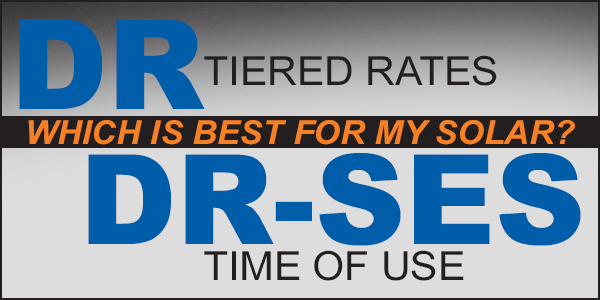
SDGE is making some significant changes to the way customers are charged for electricity. For many customers who have already installed solar, some of the potential savings may be left on the table unless you switch to the DR-SES rate structure. On the typical tiered rate structure (DR), you get a 1-for-1 exchange rate for energy sent to the grid when solar production is higher than immediate on-site consumption. With the time-of-use rate structure (DR-SES), you have the opportunity to be compensated at much higher rates for on-peak Summer production while being charged less for energy consumed when the solar system isn’t producing at night during semi-peak and off-peak hours. Signing up for this new rate structure now may also provide added value and protect your compensation as SDGE shifts all customers to time-of-use in 2019.
TIERED RATES AS OF JANUARY 1, 2017
Tier 1 & Tier 2 combined. New Tier 1 includes 130% of Baseline Allowance, which is calculated based on your Climate Zone (Coastal, Inland, Mountain, and Desert) and whether you have electric/gas service or all-electric. This new “baseline” of 130% ranges from about 380-650 kWh/mo for electric/gas households during the Summer (depending on your climate zone).
Energy sent to the grid will almost always be credited at Tier 1 rates, meaning that you’ll get about $0.19/kWh for electricity exported to the grid. In months of high usage, if you exceed 130% of Baseline, you’ll end up paying Tier 2 rates from NEM credits you have built up throughout the year.
TIME OF USE RATES AS OF AUGUST 1, 2016
From May 1st to October 31st, Summer rates go into effect. This is also about the time that your solar panel system produces more electricity. Usage of air conditioning systems also goes up during this timeframe, which is mostly offset by solar production and immediate on-site consumption. Whatever is left is exported to the grid, earning you On-Peak rates to be credited to your Net Metering (NEM) account.
At night during the Summer, you consume electricity at rates about half the price of On-Peak rates. This means that all the solar energy exported to the grid during the day earns you about 2x the kilowatt-hours for later use.
Winter rates do not have an On-Peak period, and the difference between Semi-Peak and Off-Peak energy is less significant. During these months, your export vs import from the grid will resemble similar compensation to the tiered rate structure.
Utilizing the DR-SES time-of-use rate structure typically yields between 10%-15% better compensation than the default DR rate structure. SDGE doesn’t make the switch for you, though, so it requires filing a form with the utility and possibly some follow-up to ensure that your rate structure has been correctly changed.
CLICK HERE TO DOWNLOAD THE RATE CHANGE FORM
Among many other changes, SDGE is expected to shift the On-Peak charges to later in the day, possibly as soon as 2017. This will diminish the value of solar compensation during the day and increase the price of evening energy usage when demand is at its peak, leading to increased costs for all customers. You can protect the current peak period by voluntarily switching to the DR-SES time-of-use rate structure now, which will lock in the current schedule for 5 years from the date your NEM account was activated.

2017
While the adjustments that went into effect this month have come as a shock to some SDGE customers, this is just the beginning. SDGE’s rate structure transition plan has several HUGE milestones coming in the next few years. This transition to two tiers is only temporary, as SDGE will be adding a “Super User Surcharge” in 2017. Once enacted, this will apply to residential customers using more than 400% of the baseline amount (or about 1,200/kWh per month). Pricing for Super Users will be “more than double” Tier 1 pricing, according to SDGE. As Tier 1 pricing creeps up and Tier 3 pricing trickles downward (with the goal of a 25% differential between the two tiers), this Super User Surcharge is expected to cost $0.40-$0.50/kWh, again creating a significant gap in cost between baseline and top tier energy. Although this strategy seems to fly in the face of the tier “flattening” SDGE and other major California utilities have pushed for, these changes have been approved by the California Public Utilities Commission.
2018
CARE rates, a low-income subsidy program that allows for discounted electricity rates, will be changing as well. Discounts will be phased in, reducing from 41% to 35% by 2020.
2019
Time-Of-Use Rates will be implemented for all residential customers. This type of rate structure may be more familiar for commercial customers and some solar households already, but at some point in 2019, all residential customers will pay significantly higher prices for electricity consumed from the grid during peak demand periods. On-Peak pricing is currently about double the cost of Off-Peak pricing (depending on your rate structure and the season). This On-Peak period is currently set at 11am-6pm Monday-Friday during the months of May through October. This is actually an advantage for solar customers on the DR-SES rate structure, which allows solar over-production sent to the grid to be credited at retail rates (currently about $0.47/kWh). This On-Peak window is expected to be changed, as soon as 2017, to 2pm-9pm. Solar households that elect to switch to the DR-SES rate structure before this change will get to keep the 11am-6pm window for 5 years from the date their solar PV system was activated.
CLICK HERE FOR MORE INFORMATION ABOUT FUTURE CHANGES TO SDGE’S RATE STRUCTURES & PRICING
QUESTIONS ABOUT YOUR SDGE RATE STRUCTURE?
